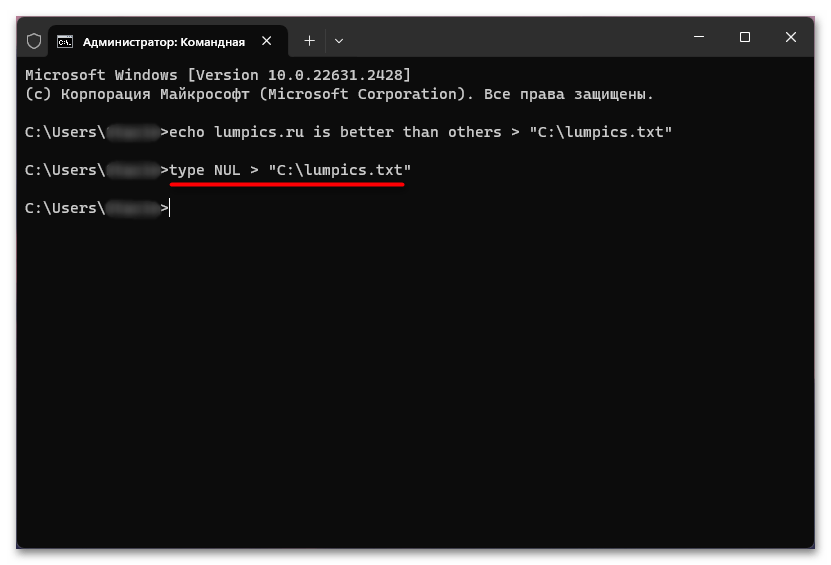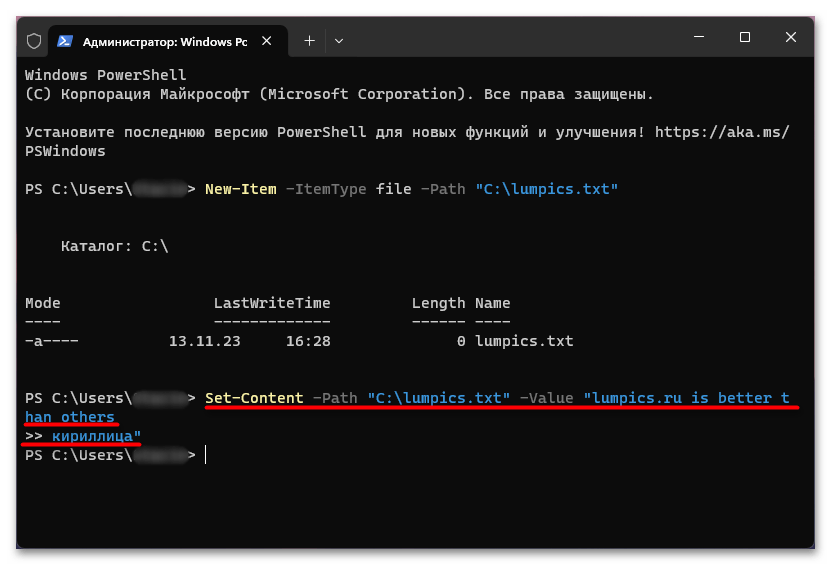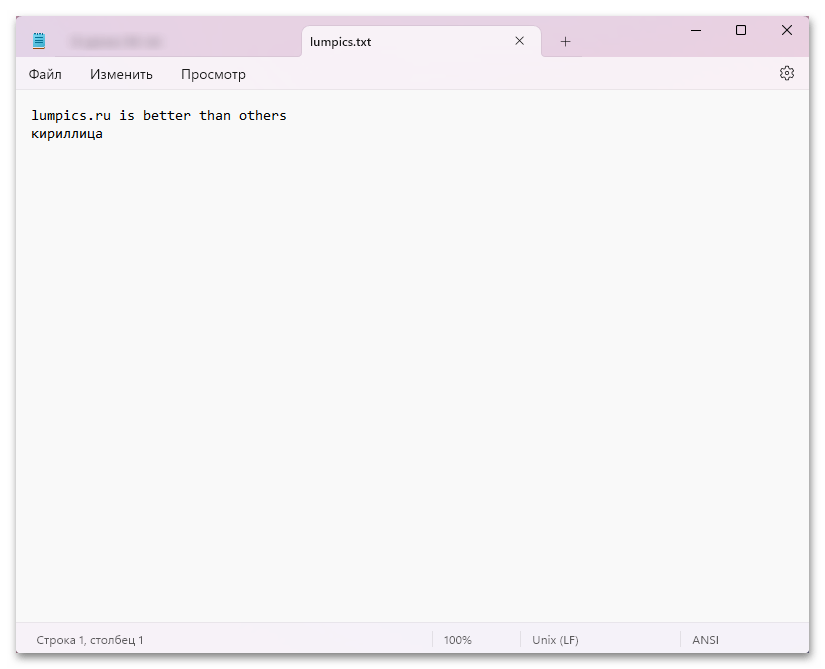Все способы:
- Способ 1: Контекстное меню
- Способ 2: Запуск приложения «Блокнот»
- Способ 3: Использование приложения WordPad
- Способ 4: Консоль
- «Командная строка»
- «Терминал»
- Вопросы и ответы: 0
Если вы попали в эту статью не узнать о способах создания текстового документа, а по причине того, что создать его не удается, ознакомьтесь с нашей инструкцией, где описаны разные решения этой неполадки.
Подробнее: Решаем проблему с созданием текстового документа в Windows 11
Способ 1: Контекстное меню
Довольно простой метод создания обычного TXT-документа заключается в использовании контекстного меню.
- Его можно вызвать не только на рабочем столе, как показано ниже, но и в любой папке, кликнув правой кнопкой мыши по пустому месту. Наведите курсор на «Создать» и выберите «Текстовый документ».
- Вы увидите созданный файл без названия и с расширением .txt. Введите любое название файла и нажмите Enter. Если создаете файл для выполнения скрипта, расширение тоже отредактируйте на .reg или .bat (открыть потом сам документ для редактирования можно через ПКМ по нему > «Открыть с помощью» > «Блокнот», в то время как нажатие ЛКМ запустит файл, который у вас после создания, естественно, пустой). Менять расширение на условный .docx нельзя, поскольку у системы отсутствуют такие возможности по преобразованию. Доступно конвертирование только в более простые типы типа .rtf.
- Откройте документ, введите туда нужный текст и сохраните его, нажав клавиши Ctrl + S либо вызывав меню «Файл» в верхней части окна.
Через него же можете выбрать опцию «Сохранить как», чтобы переименовать созданный документ, изменить для него путь и задать другую кодировку. Обратите внимание, что в результате такого сохранения вы создадите отдельный файл, то есть изначально созданный документ через контекстное меню останется в первоначальном виде (пустым), а то, что вы сохраняете, появится в указанной директории отдельным файлом.
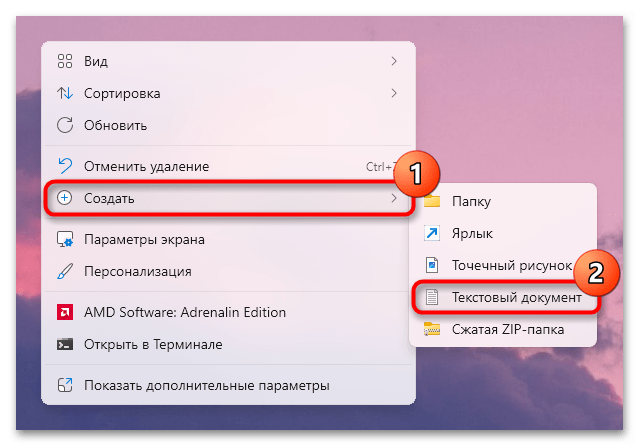
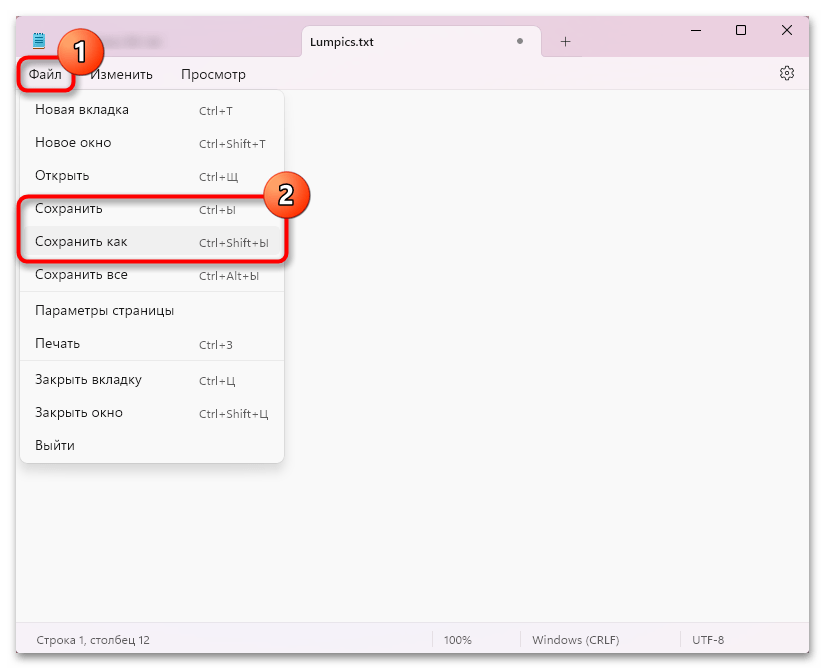
Способ 2: Запуск приложения «Блокнот»
Рассмотренный выше процесс создания и наполнения текстового файла выполнялся через системное приложение «Блокнот». Оно встроено в Windows по умолчанию и, как правило, именно им пользуются для создания TXT-файлов.
Соответственно, запустив это приложение через «Пуск» или другим удобным способом, вы сможете создавать текстовые документы и сохранять их в любом месте на компьютере.
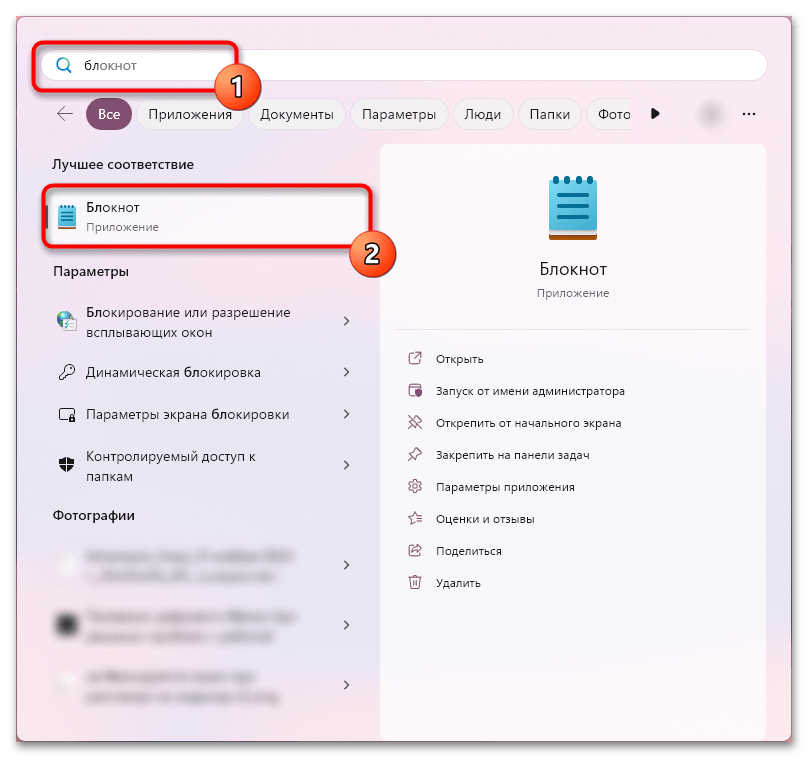
В отличие от предыдущего способа, здесь не создается текстовый документ, который остается отдельным файлом в результате использования функции «Сохранить как».
Если вы запускаете приложения альтернативными вариантами, то открыть «Блокнот» можете командой notepad либо notepad.exe.
Способ 3: Использование приложения WordPad
В Windows существует и простой текстовый редактор, тем не менее предоставляющий больше функций по форматированию и работе с документами, нежели примитивный «Блокнот».
- Через системный поиск отыщите приложение «WordPad» и запустите его.
- Введите текст и оформите его при помощи доступных инструментов. Учитывайте особенности расширений — например, при сохранении в TXT все форматирование будет удалено.
- Выбрать расширение или задать свое можно из списка в «Файл» > «Сохранить как».
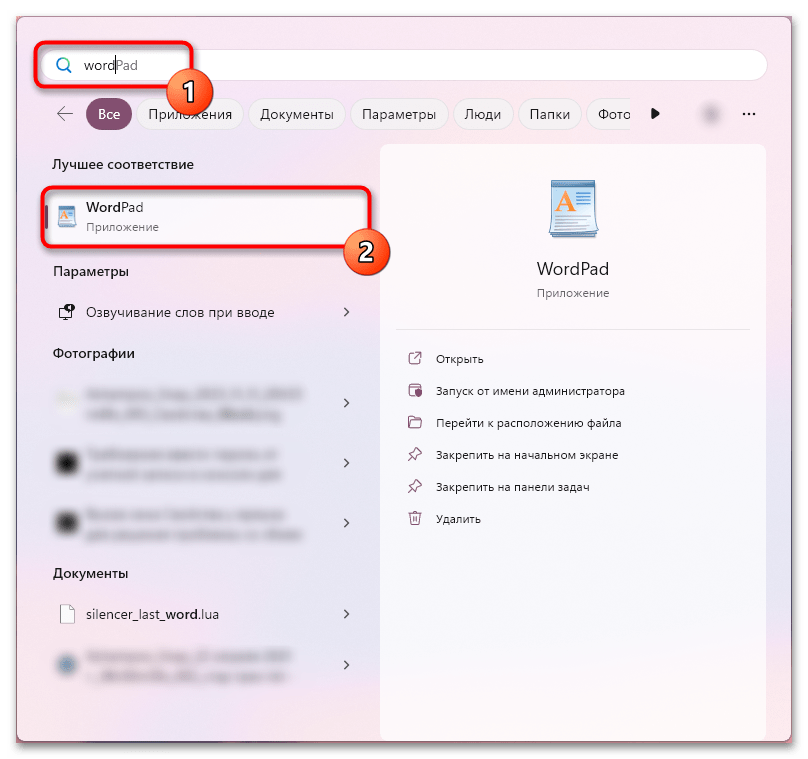
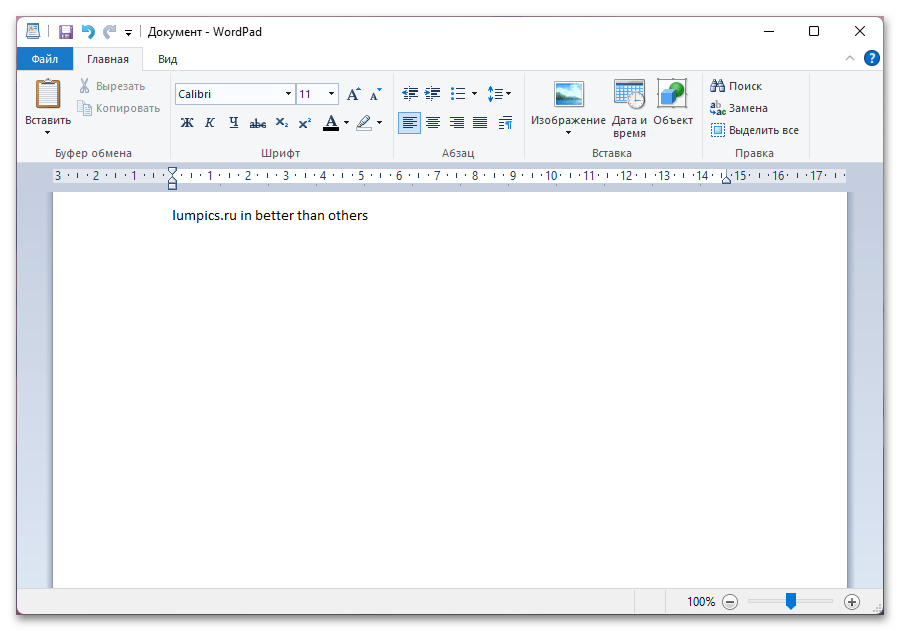
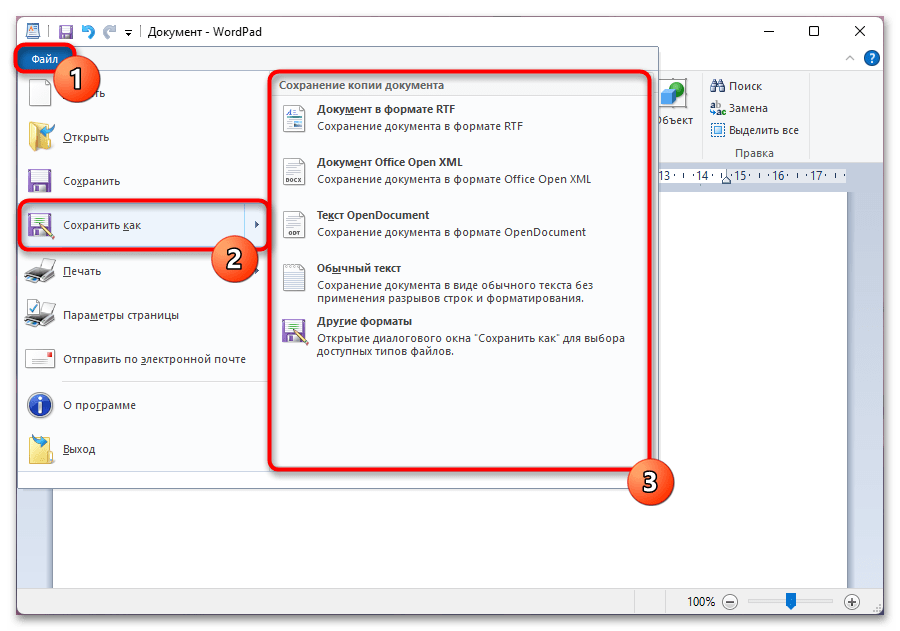
Способ 4: Консоль
В зависимости от выбранной консоли необходимо задействовать разные команды для создания текстового документа. Запустить любую из консолей вы можете, кликнув правой кнопкой мыши по «Пуску» и выбрав пункт «Терминал» или «Терминал (Администратор)», если требуется создать файл в одной из системных директорий.
«Командная строка»
Классическая «Командная строка» позволяет создать как пустой текстовый документ, так и с текстом. Единственный минус — не поддерживаются кириллические символы.
- Запустить эту консоль можно в «Терминале», кликнув по кнопке со стрелкой вниз и из выпадающего списка выбрав «Командная строка».
- Самая известная команда для выполнения поставленной задачи —
copy con C:\Путь\К\Файлу\НазваниеДокумента.txt. В нашем примере этоcopy con C:\lumpics.txt. Если вам надо создать документ, например, на рабочем столе, команда будет выглядеть следующим образом:C:\Users\Имя_Пользователя\Desktop\lumpics.txt, где вместо Имя_Пользователя — название вашей учетной записи, а вместо lumpics — имя файла.Аналогичные пути будут и к другим часто используемым директориям:
C:\Users\Имя_Пользователя\Documents— для папки «Документы»,C:\Users\Имя_Пользователя\Downloads— для папки «Загрузки». Конечно, вместо директорий на системном диске вы можете сохранять файлы и на другие тома, например на D. - Сформировав команду, нажмите Enter. В результате курсор переместится на строку ниже, где вам понадобится ввести текст, который и будет сохранен внутри документа.
- Теперь нажмите Ctrl + Z, а затем Enter для сохранения документа. Уведомление об этом вы увидите в виде строки «Скопировано файлов: 1». Отметим, что после нажатия Ctrl + Z в конце текста появятся символы ^Z, однако в самом документе их не будет.
- Как видите, файл успешно создался в выбранной директории.
- А в нем содержится введенный через консоль текст.
- Однако, если вы захотите создать документ с кириллическими символами, то сделать это не получится.
- Как уже было сказано выше, вместо текста будут отображаться кракозябры.

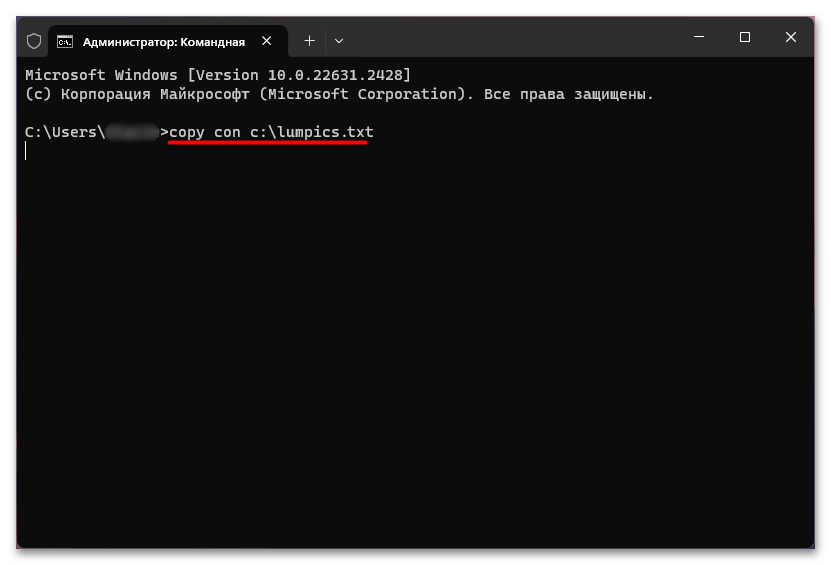
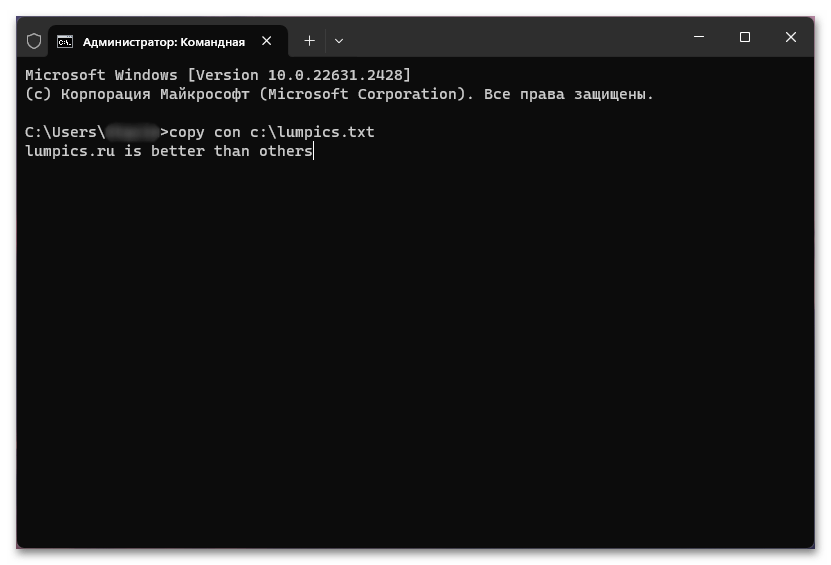
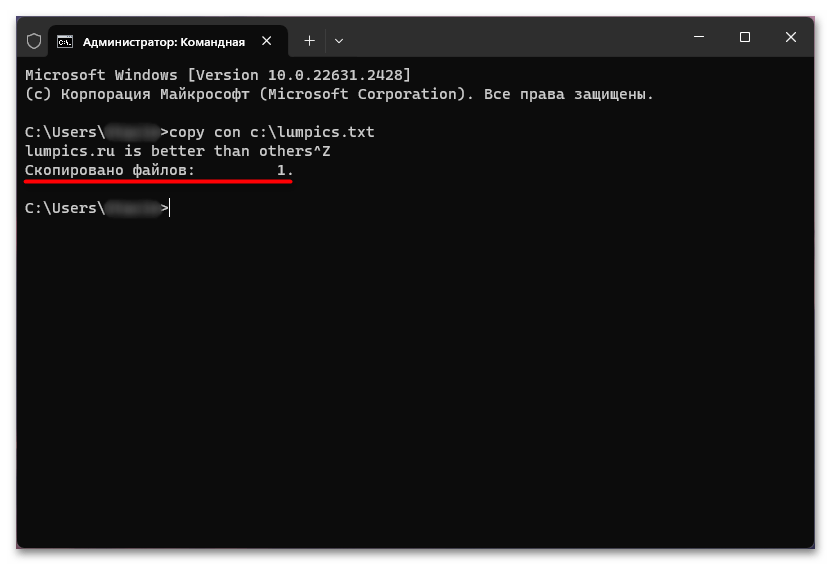
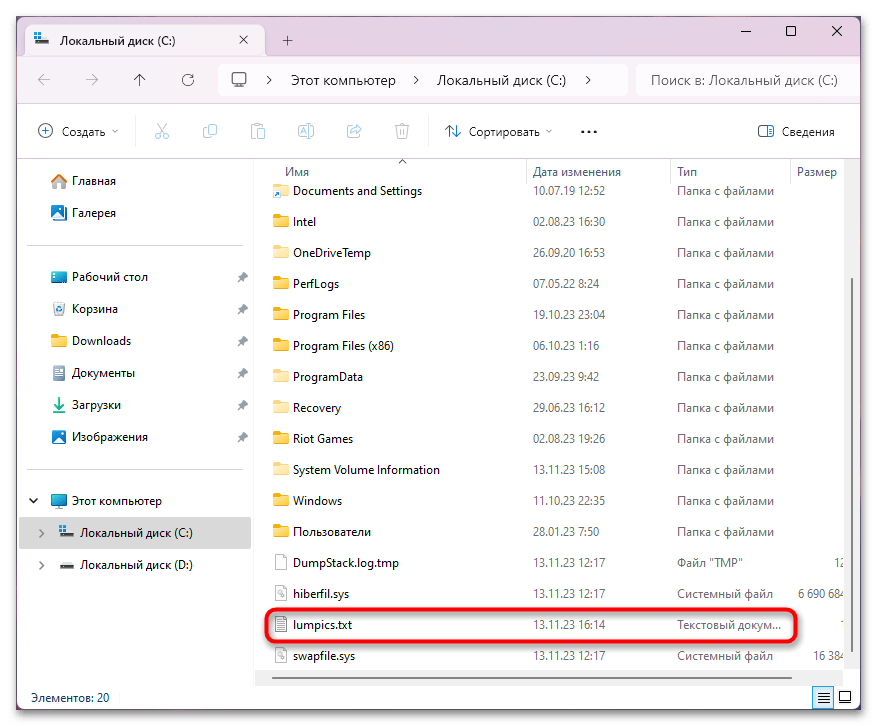
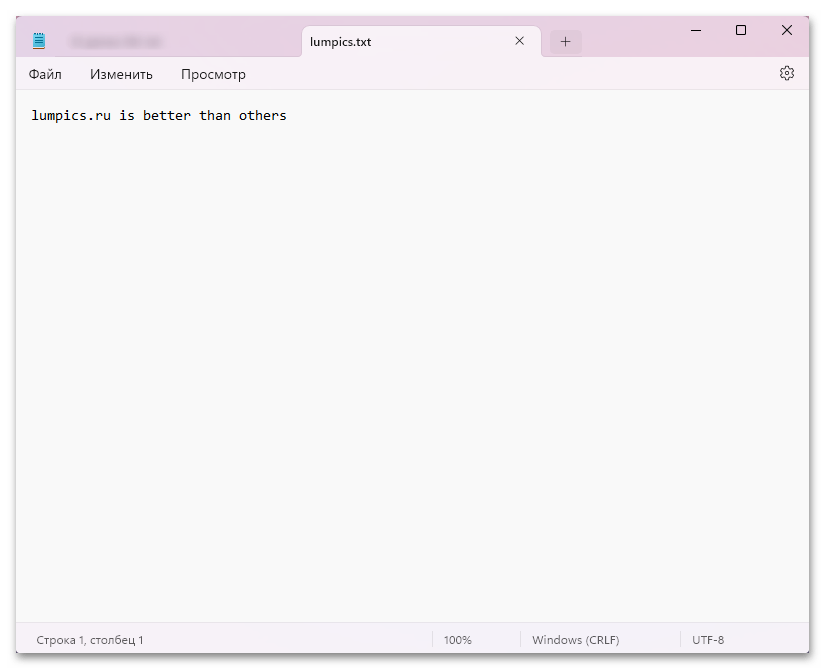
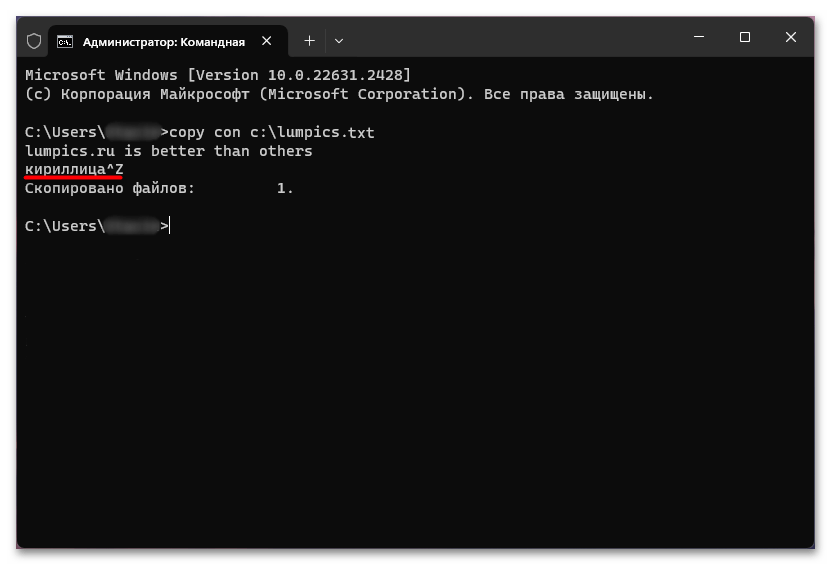
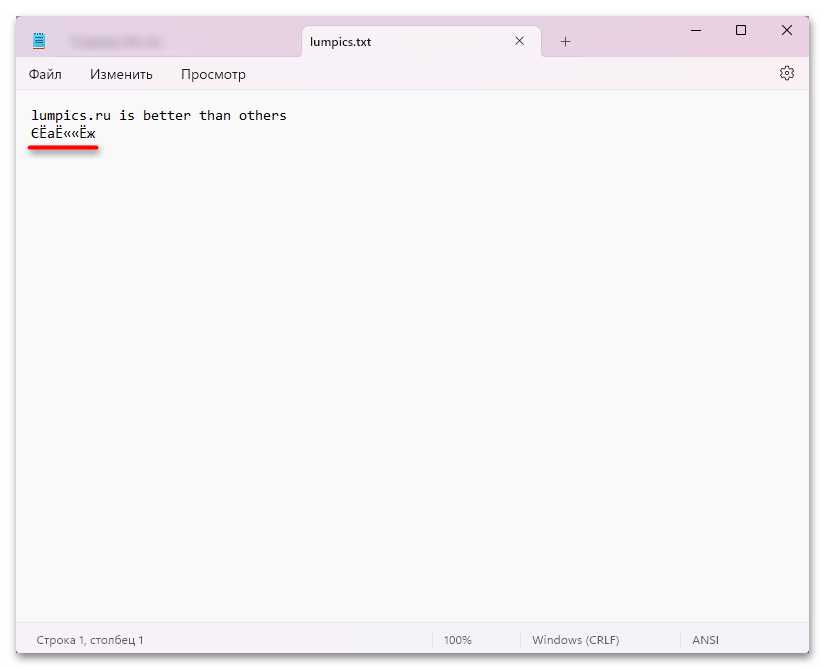
- Помимо copy con, текстовый документ с содержимым можно создать и через команду
echo Ваш текст > "C:\Путь\К\Файлу\НазваниеДокумента.txt", заменив Ваш текст нужным текстом, C:\Путь\К\Файлу — на директорию, где будет создан документ, НазваниеДокумента — на имя файла. Кириллические символы тут так же нормально не отобразятся. - Для пустого текстового документа используйте команду
type NUL > "C:\Путь\К\Файлу\НазваниеДокумента.txt".Пустой файл успешно создан.
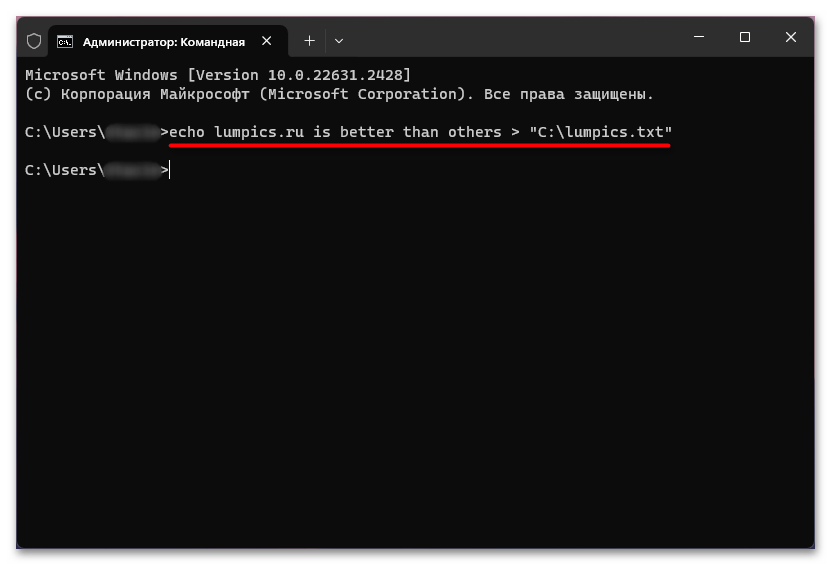
«Терминал»
Через современный «Терминал», работающий на базе «PowerShell», также можно реализовать задуманное. В отличие от «Командной строки», при создании документа с текстом вы сможете использовать кириллические символы. Однако сами по себе команды длиннее, и от этого труднее запоминаются.
- Если вас интересует создание документа сразу с текстом, воспользуйтесь командой
Set-Content -Path "C:\Путь\Файлу\НазваниеДокумента.txt" -Value "Ваш текст". Вводимый текст можете переносить на новую строку, нажимая Ctrl + Enter. При нажатии просто на Enter команда будет выполнена.Как видно, кириллические символы корректно сохраняются наряду с латиницей.
- Команда, создающая пустой текстовый файл, выглядит следующим образом:
New-Item -ItemType file -Path "C:\Путь\К\Файлу\НазваниеДокумента.txt".
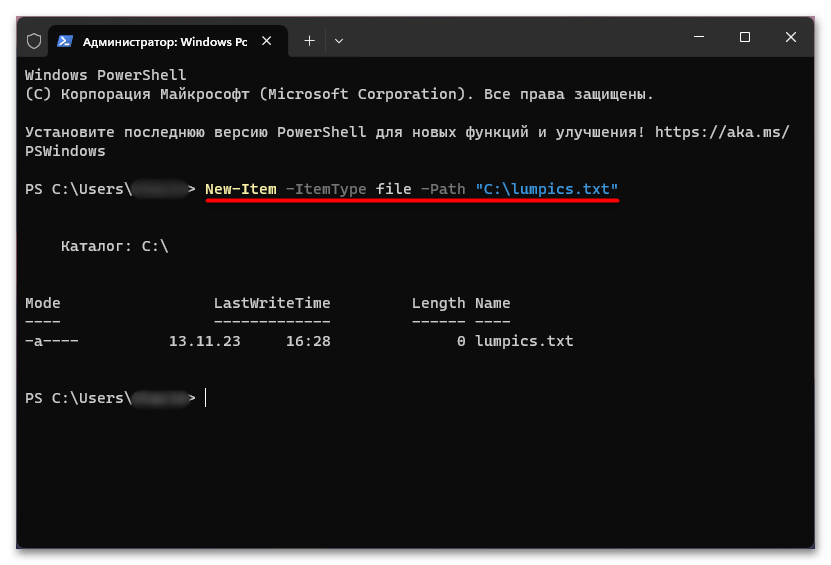
Наша группа в TelegramПолезные советы и помощь
Creating a new text file in Windows 11 is an essential skill for anyone using the operating system, whether for casual purposes like jotting down notes or for more professional tasks such as coding and document creation. In this article, we will explore several methods to create a new text file in Windows 11, detailing each step in a clear, concise manner. We’ll cover the built-in applications, use of keyboard shortcuts, and other tools to tailor your file creation experience according to your needs.
Understanding Text Files
Before diving into the methods for creating a text file, it’s important to understand what a text file is. A text file is a universally readable format that contains plain text. Unlike rich text files, which may include styled text and media elements, text files primarily store unformatted text. This makes them highly versatile for various tasks, including programming, note-taking, and system configurations.
Prerequisites
Before we begin, ensure that your system is running Windows 11 to follow the instructions accurately. Familiarity with basic computer operations, such as using a mouse and keyboard, will also be beneficial.
Method 1: Creating a Text File Using File Explorer
One of the simplest ways to create a new text file in Windows 11 is through File Explorer. Here’s how to do it step by step:
-
Open File Explorer: Click on the File Explorer icon on the taskbar. It looks like a folder. Alternatively, you can press
Windows + Eon your keyboard to open it quickly. -
Navigate to Your Desired Location: Browse to the folder where you want to create the new text file. It could be on your desktop, in Documents, or in any other directory.
-
Open the Context Menu: Right-click in an empty area within the window. This action will open a context menu.
-
Select «New»: Hover your mouse pointer over the «New» option in the context menu. This will expand a secondary menu.
-
Choose «Text Document»: From the expanded menu, select «Text Document.» A new text file will appear in the directory.
-
Rename the Text File: By default, the new text file will be named «New Text Document.txt.» You can rename it immediately by typing your preferred name and pressing Enter.
Method 2: Using the Context Menu in the Desktop
You can also create a text file directly from your desktop, which might be more convenient for quick notes.
-
Right-click on Your Desktop: Go to an empty area on your desktop and right-click.
-
Select «New»: Navigate to the «New» option in the context menu.
-
Choose «Text Document»: Click on «Text Document.» A new text file will appear on your desktop.
-
Rename the File: Again, the new file will be named «New Text Document.txt» by default. Simply type a new name for it and hit Enter.
Method 3: Creating a Text File Using Notepad
Notepad is a built-in application in Windows 11 that allows users to create, edit, and save text files. Here’s how you can create a text file using Notepad:
-
Open Notepad: Click on the Start menu (Windows icon) on the taskbar and type «Notepad.» Click on the Notepad application from the search results.
-
Create Your Content: Once Notepad opens, you can start typing your content as needed.
-
Save Your File:
- Click on the “File” menu in the upper-left corner.
- Select “Save As.”
- Choose the location where you want to save the file, name your file in the «File name» field, and ensure that you include «.txt» at the end to save it as a text file.
- Click “Save.”
Method 4: Creating a Text File Using Windows Terminal or Command Prompt
If you’re someone who enjoys using command-line interfaces, you can create a text file using Windows Terminal or Command Prompt. Here’s how:
-
Open Windows Terminal or Command Prompt: You can search for «Terminal» or «Command Prompt» in the Start menu.
-
Navigate to Your Desired Folder: Use the
cdcommand to change the directory to where you want to create the text file. For example, if you want to save it in Documents, type:cd Documents -
Create the Text File: Type the following command and replace «filename.txt» with your desired file name:
type nul > filename.txtThis command generates an empty text file in the specified directory.
-
Confirm File Creation: You can confirm the file’s existence by typing
dirto list the files in your current directory.
Method 5: Creating a Text File Through the Run Dialog
Windows 11 also allows users to create files from the Run dialog, a lesser-known but effective method.
-
Open the Run Dialog: Press
Windows + Rto open the Run dialog box. -
Type the Following Command: Type
notepad.exe filename.txtand replace «filename.txt» with your preferred file name. -
Press Enter: This action will open Notepad with a new file created based on the name provided. You can start typing immediately.
-
Save Your File: Click on «File» in the upper left corner and select «Save As» to choose the file’s location and save it.
Method 6: Creating a Text File Using WordPad
For those who require some formatting capabilities along with plain text storage, WordPad comes in handy.
-
Open WordPad: Search for «WordPad» in the Start menu and open the application.
-
Create Your Content: Type in your text as you desire. WordPad allows some rich-text formatting, offering features like changing fonts and text sizes.
-
Save the File:
- Click «File» in the top left corner.
- Select «Save As.»
- Choose «Plain Text Document» from the different formats available.
- Type in your desired file name and select a location to save the file.
Additional Tips for Managing Text Files
After creating your text files, you may need to manage them effectively. Here are a few tips to enhance your productivity:
-
Organize Your Files: Create folders within your directories to categorize your files based on projects, subjects, or any system that makes sense to you.
-
Use Descriptive Names: When naming your text files, make them descriptive to quickly identify contents without needing to open them.
-
Utilize File Extensions: While creating a text file, always ensure the extension is
.txtto avoid compatibility issues with other applications. -
Backup Your Files: Use cloud storage solutions or external drives to backup your important files regularly to avoid data loss.
Conclusion
Creating a new text file in Windows 11 is straightforward, with multiple methods to suit various user preferences. Whether you choose to use the familiar GUI approach via File Explorer, harness the power of command-line tools, or take advantage of built-in applications like Notepad and WordPad, you now have the knowledge to create text files easily.
By following the steps outlined in this article, you can confidently create text files that serve your needs, whether for simple note-taking or more complex documentation. Remember to keep your files organized and backed up to ensure smooth productivity and data safety in your daily activities.
Windows 11 TXT File: A Comprehensive Guide
The TXT file is a simple text file that has been used for decades to store data. It is a popular format for storing code, configuration settings, and other text-based information. In this comprehensive guide, we will discuss everything you need to know about TXT files, including how to create, edit, and open them in Windows 11. We will also cover some of the common problems that people have with TXT files and how to solve them.
By the end of this guide, you will be a TXT file expert! You will know how to use TXT files to store your data, and you will be able to troubleshoot any problems that you encounter. So let’s get started!
| Column 1 | Column 2 | Column 3 |
|---|---|---|
| Data 1 | Data 2 | Data 3 |
| Data 4 | Data 5 | Data 6 |
What is a TXT file?
A TXT file, also known as a text file, is a type of computer file that stores plain text. TXT files are typically created and edited using a text editor, such as Notepad or TextEdit. They can be used to store any type of text data, including letters, numbers, and symbols. TXT files are often used to store code, configuration settings, and other types of text data.
TXT files are one of the simplest and most common types of computer files. They are supported by all major operating systems, and can be opened and edited using a variety of different software programs. TXT files are also very portable, and can be easily transferred between different computers and devices.
Creating a TXT file in Windows 11 is very simple. To do this, follow these steps:
1. Open the File Explorer.
2. Navigate to the folder where you want to create the TXT file.
3. Right-click in the empty space and select **New** > Text Document.
This will create a new TXT file in the selected folder. The file will be named Untitled. You can change the name of the file by clicking on it and typing a new name.
Once you have created a TXT file, you can start typing text into it. You can use any text editor to edit a TXT file, such as Notepad or TextEdit.
To save a TXT file, click on the File menu and select Save. You will be prompted to enter a filename and location. Once you have entered the filename and location, click Save.
TXT files are very simple to create and edit. They are a great way to store text data of any type.
TXT files are a simple and versatile way to store text data. They can be created and edited using any text editor, and they are supported by all major operating systems. TXT files are also very portable, and can be easily transferred between different computers and devices.
If you need to store text data, a TXT file is a great option. They are easy to create, edit, and share.
How to open a TXT file in Windows 11
TXT files are plain text files that can be opened with any text editor. In Windows 11, you can open a TXT file using the following methods:
- Using File Explorer
1. Open File Explorer.
2. Navigate to the folder containing the TXT file.
3. Right-click on the TXT file and select Open.
- Using the Run dialog box
1. Press Windows+R to open the Run dialog box.
2. Type the following command and press Enter:
`notepad `
Where « is the name of the TXT file.
- Using the Command Prompt
1. Open the Command Prompt.
2. Type the following command and press Enter:
`notepad `
Where « is the name of the TXT file.
- Using the PowerShell
1. Open PowerShell.
2. Type the following command and press Enter:
`notepad `
Where « is the name of the TXT file.
Note: If you are unable to open a TXT file, it may be because the file is corrupted. You can try to repair the file using a file repair tool.
How to edit a TXT file in Windows 11
You can edit a TXT file using any text editor. In Windows 11, you can use the following text editors to edit TXT files:
* **Notepad**
* **WordPad**
* **Microsoft Word**
To edit a TXT file using Notepad, follow these steps:
1. Open Notepad.
2. Click **File** > **Open**.
3. Navigate to the folder containing the TXT file.
4. Select the TXT file and click **Open**.
The TXT file will be opened in Notepad. You can edit the file as needed.
To save the changes to the file, click **File** > **Save**.
To edit a TXT file using WordPad, follow these steps:
1. Open WordPad.
2. Click **File** > **Open**.
3. Navigate to the folder containing the TXT file.
4. Select the TXT file and click **Open**.
The TXT file will be opened in WordPad. You can edit the file as needed.
To save the changes to the file, click **File** > **Save**.
To edit a TXT file using Microsoft Word, follow these steps:
1. Open Microsoft Word.
2. Click **File** > **Open**.
3. Navigate to the folder containing the TXT file.
4. Select the TXT file and click **Open**.
The TXT file will be opened in Microsoft Word. You can edit the file as needed.
To save the changes to the file, click **File** > Save.
Note: When you save a TXT file in Microsoft Word, the file will be saved as a .docx file. You can open a .docx file in any text editor, but the formatting may not be preserved.
TXT files are a simple and easy way to store text data. They can be opened and edited with any text editor, and they can be shared with others easily. If you need to store text data, a TXT file is a great option.
Q: What is a TXT file?
A TXT file is a plain text file that contains unformatted text data. It is one of the most common file types and can be opened with any text editor, such as Notepad or WordPad.
Q: How do I create a TXT file?
To create a TXT file, open a text editor and type your desired content. Then, save the file with the .txt extension.
Q: How do I open a TXT file?
To open a TXT file, double-click on the file icon. You can also right-click on the file icon and select “Open with”. In the “Open with” dialog box, select the text editor that you want to use to open the file.
Q: How do I edit a TXT file?
To edit a TXT file, open the file in a text editor and make your desired changes. Then, save the file.
Q: How do I delete a TXT file?
To delete a TXT file, right-click on the file icon and select “Delete”. You can also delete a TXT file by dragging it to the Recycle Bin.
Q: What are the advantages of using a TXT file?
TXT files are lightweight and easy to create and share. They are also compatible with a wide variety of devices and software applications.
Q: What are the disadvantages of using a TXT file?
TXT files are not as versatile as other file formats, such as PDF or Word documents. They cannot contain images, formatting, or other elements that are common in other file formats.
Q: How can I protect a TXT file?
You can protect a TXT file by encrypting it. Encryption is a process that scrambles the data in a file so that it cannot be read without a password. You can encrypt a TXT file using a variety of different tools, such as the built-in encryption features in Windows or third-party encryption software.
In this blog post, we have discussed how to create, open, edit, and save TXT files in Windows 11. We have also covered how to use the Notepad app to format text, add hyperlinks, and insert images. Finally, we have provided some tips for troubleshooting common TXT file problems.
We hope that this information has been helpful. If you have any other questions about TXT files, please feel free to leave a comment below.
Author Profile
-
Hatch, established in 2011 by Marcus Greenwood, has evolved significantly over the years. Marcus, a seasoned developer, brought a rich background in developing both B2B and consumer software for a diverse range of organizations, including hedge funds and web agencies.
Originally, Hatch was designed to seamlessly merge content management with social networking. We observed that social functionalities were often an afterthought in CMS-driven websites and set out to change that. Hatch was built to be inherently social, ensuring a fully integrated experience for users.
Now, Hatch embarks on a new chapter. While our past was rooted in bridging technical gaps and fostering open-source collaboration, our present and future are focused on unraveling mysteries and answering a myriad of questions. We have expanded our horizons to cover an extensive array of topics and inquiries, delving into the unknown and the unexplored.
Latest entries
Creating a new text file in Windows 11 is a simple yet essential task that can be beneficial for numerous purposes, such as note-taking, coding, writing documents, or gathering information. Windows 11, an operating system that has brought a fresh design and enhanced functionality to the Windows environment, offers multiple methods to create a new text file. In this article, we will delve into the various ways you can create a new text file in Windows 11, explore the tools you can use, and offer tips to enhance your experience. This guide will encompass different approaches, from traditional methods to more advanced techniques tailored for users with specific needs.
Understanding Text Files
To begin, it’s crucial to understand what a text file is. A text file is a type of computer file that contains plain text, which is encoded in a character encoding such as ASCII or Unicode. Unlike other file formats like Microsoft Word documents or PDFs, a plain text file does not contain any formatting (such as bold or italics), making it easy to read and edit. Text files are widely used for scripts, logs, configuration files, and everything in between.
Creating a New Text File Using Notepad
One of the most straightforward methods to create a text file in Windows 11 is using Notepad. This simple text editor comes pre-installed with the operating system and offers a basic interface for writing and saving text files.
Step-by-Step Process:
-
Open Notepad:
- You can do this by clicking on the Start Button on the taskbar and typing «Notepad» in the search bar. Click on the Notepad app when it appears in the search results.
-
Write Your Text:
- Once Notepad is open, you can start typing the content you wish to save in the text file.
-
Save the File:
- After typing, go to the File menu in the top left corner and click on Save As.
- In the Save As dialog, choose the location where you want to save the file (e.g., Documents, Desktop).
- In the File Name field, enter your desired filename, making sure to end it with the “.txt” extension, such as «myfile.txt».
- Click the Save button.
Creating a Text File Using File Explorer
Another popular method to create a text file is through the Windows File Explorer, which allows for quick and efficient file management.
Step-by-Step Process:
-
Open File Explorer:
- You can do this by selecting the folder icon on the taskbar or pressing
Windows + Eon your keyboard.
- You can do this by selecting the folder icon on the taskbar or pressing
-
Navigate to Your Desired Folder:
- Browse to the folder where you want to create the new text file. This could be anywhere, such as the Documents folder, the Desktop, or any other directory.
-
Right-Click to Create a New File:
- Once you’re in the desired folder, right-click on an empty space. This will prompt a context menu to appear.
-
Select New:
- In the context menu, hover over the New option, and a sub-menu will appear.
-
Choose Text Document:
- Click on Text Document from the sub-menu. A new text document will appear, typically named «New Text Document.txt».
-
Rename the Text File:
- You can rename the file by clicking on the name and typing your preferred file name before pressing Enter.
Using Windows Terminal to Create a Text File
For users who are comfortable with command line interfaces, Windows Terminal presents an efficient method for creating a text file.
Step-by-Step Process:
-
Open Windows Terminal:
- You can find Windows Terminal by searching for it in the Start menu.
-
Navigate to the Desired Directory:
- Use the
cdcommand to change your directory to where you would like the text file to be created. For example:cd Documents
- Use the
-
Create the Text File:
- To create a new text file, you can use the
echocommand:echo. > myfile.txt - This command creates an empty text file named «myfile.txt».
- To create a new text file, you can use the
-
Verify the File Creation:
- You can use the
dircommand to list files in the directory and confirm that your new text file has been created.
- You can use the
Creating a Text File Using Microsoft Word
If you prefer using Microsoft Word, you can also create a simple text file by leveraging Word’s ability to save documents in plain text format.
Step-by-Step Process:
-
Open Microsoft Word:
- Click the Start menu and search for Microsoft Word, then open it.
-
Create a New Document:
- Once Word is open, select Blank Document to start a new file.
-
Enter Your Text:
- Type your desired content within the Word document.
-
Save as Plain Text:
- Click on File, then choose Save As.
- In the Save As dialog box, select the destination folder.
- In the Save as type dropdown menu, select *Plain Text (.txt)**.
- Name your file and click Save.
Keyboard Shortcuts for Speed
Windows 11 includes several keyboard shortcuts that can streamline the process of creating text files. Here are a few useful shortcuts:
- Win + R: Opens the Run dialog. You can type «notepad» to quickly open Notepad.
- Ctrl + N: In Notepad, this shortcut opens a new window.
- Ctrl + S: Saves your current document in Notepad, allowing for quick saves without navigating through menus.
Mastering these shortcuts will significantly enhance your efficiency while working with text files.
Customizing Your Text Files
After creating your text file, you may want to customize it further. There are several aspects you can consider:
File Naming Conventions
Using appropriate file naming conventions can help you maintain organization. Consider including dates or keywords relevant to the content. For example:
- «MeetingNotes_2023_10_31.txt»
- «Projects_TodoList.txt»
File Extension Awareness
While ‘.txt’ is the standard extension for text files, Windows allows you to create other types of text files such as ‘.csv’ or ‘.log’, depending on your needs. Make sure to select the correct extension based on the intended use of your file.
Content Formatting
Although basic text files do not support formatting, if you wish to maintain certain structures, consider using tabs or specific punctuation to delineate sections.
Advanced Techniques for Power Users
For advanced users or those looking to optimize their workflow, consider these additional tips:
Scripting with PowerShell
You can create text files even more efficiently by using PowerShell, particularly for automating tasks.
-
Open PowerShell:
- Search for PowerShell in the Start menu.
-
Use the New-Item Command:
- To create a new text file, run the command:
New-Item -Path "C:pathtoyourfolderyourfile.txt" -ItemType File
- To create a new text file, run the command:
This approach is particularly useful for batch file creation or managing multiple files at once.
Automating File Creation with Batch Files
A batch file can be created to automate text file generation:
-
Open Notepad:
- Write the commands you want to execute, for instance:
@echo off echo This is my new text file> myfile.txt
- Write the commands you want to execute, for instance:
-
Save as .bat:
- Save the file with a
.batextension, and run this batch file to create the new text file automatically.
- Save the file with a
Conclusion
Creating a new text file in Windows 11 is a fundamental skill that can enhance your productivity, whether for personal use, academic purposes, or professional requirements. With various methods at your disposal—from utilizing Notepad and File Explorer to working with Windows Terminal and Microsoft’s Word application—you can easily generate text files tailored to your needs.
Best Practices
As you continue to work with text files, remember these best practices:
- Organize Your Files: Create a systematic folder structure, grouping related files together.
- Backup Important Files: Regularly back up your text files to prevent data loss.
- Use Version Control: If your text files are part of a project, consider utilizing version control systems like Git to track changes and collaborate with others.
By mastering these simple techniques and approaches under Windows 11, not only will you be able to create text files effectively, but you’ll also elevate your overall computing proficiency. Embrace these functionalities to streamline your workflow and unleash the full potential of Windows 11 at your fingertips.
How to Create a New Text File in Windows 11
Creating a new text file in Windows 11 is an essential skill for anyone using a computer, whether for personal projects, academic work, or professional activities. Windows 11 offers several methods to create text files, each with its own advantages depending on user preference and needs. This article will explore various approaches to creating new text files in Windows 11, providing step-by-step instructions, tips, and additional information to enhance your experience.
Method 1: Using Notepad
Notepad is a simple yet powerful text editor included in Windows 11. It is straightforward to use for creating and editing text files.
-
Open Notepad:
- Click on the Start Menu (Windows icon) located at the bottom left corner of your screen.
- In the search bar, type Notepad and press Enter. When Notepad appears in the search results, click on it.
-
Create a New File:
- With Notepad open, click on File in the top left corner of the window.
- Select New. A blank document will appear, allowing you to begin typing.
-
Save the File:
- Once you have typed your content, save your work by clicking on File and then Save As.
- Choose the location where you want to save the file. This could be your Desktop, Documents folder, or any other preferred location.
- Name your file in the File Name field and ensure to add the .txt extension to signify it is a plain text file (e.g., myfile.txt).
- Click Save.
Method 2: Using Right-Click Context Menu
Windows 11 allows users to create a new text file directly from the right-click context menu for quick access.
-
Navigate to Your Desired Location:
- Open File Explorer by clicking the folder icon on your taskbar or by pressing Windows + E.
- Browse to the location where you want to create your new text file.
-
Right-Click to Create:
- Right-click on an empty space within the folder.
- Hover over New in the context menu that appears.
- Click on Text Document. This will instantly create a new text file named New Text Document.txt in the selected folder.
-
Rename and Edit:
- The new text file will be ready for naming. Type your desired name (remember to keep the .txt extension) and press Enter.
- Double-click the newly created text file to open it in Notepad or your default text editor.
Method 3: Using the Run Dialogue
For users who appreciate keyboard shortcuts, the Run Dialogue provides a fast method to create a text file.
-
Open Run Dialogue:
- Press Windows + R on your keyboard to open the Run Dialogue box.
-
Execute Notepad:
- Type the command
notepadand press Enter. This will launch the Notepad application.
- Type the command
-
Creating and Saving:
- Type your text, then click on File > Save As.
- Choose your save location, enter the file name with a .txt extension, and click Save.
Method 4: Using Windows Terminal
Windows Terminal is a powerful command-line tool that can also be used to create text files.
-
Open Windows Terminal:
- Right-click the Start Menu and select Windows Terminal. Alternatively, you can search for “Windows Terminal” in the Start Menu.
-
Navigate to the Desired Directory:
- Use the
cdcommand followed by the path to navigate to the folder where you want to create the text file. For example:cd C:UsersYourUsernameDocuments
- Use the
-
Create the Text File:
- Use the
echocommand to create a text file. For example:echo. > myfile.txt - This command will create a new text file named myfile.txt in the current directory.
- Use the
-
Edit the File:
- You can open the created text file with Notepad by typing:
notepad myfile.txt
- You can open the created text file with Notepad by typing:
Method 5: Using Microsoft Word or Other Text Editors
For users who prefer more advanced text editing features, creating a text file using Microsoft Word or other text editors can be functional.
-
Open Microsoft Word:
- Start Microsoft Word from the Start Menu or taskbar.
-
Create a New Document:
- Click on Blank document to get started.
-
Draft Your Text:
- Type your content. Unlike Notepad, Word offers rich formatting options, so feel free to utilize them if necessary.
-
Save As a Text File:
- Click on File > Save As.
- In the dialog box, select the destination folder.
- Change the filename and select Plain Text from the Save as type dropdown menu. This will ensure your file is saved with a .txt extension.
- Click Save.
-
Confirm Formatting Import:
- If prompted about text encoding, simply click OK to apply the default settings.
Tips for Managing Text Files
-
File Naming Conventions: When naming your text files, be descriptive. This will help you find them later. Avoid using special characters in file names, as they may cause issues on different platforms.
-
Organizing Files: Create folders within your directories to categorize your text files. For instance, you could have separate folders for personal, academic, and professional documents.
-
Regular Backups: Regularly back up your important text files. Use cloud storage solutions like OneDrive, Google Drive, or external hard drives to ensure you don’t lose valuable information.
-
Using File Extensions Wisely: Besides .txt, Windows also supports other text file formats like .csv (for spreadsheets) and .log (for log files). Choose the appropriate extension based on your needs.
Conclusion
Creating a new text file in Windows 11 can be accomplished through various methods, ranging from simple applications like Notepad to more advanced tools such as Windows Terminal or Microsoft Word. By mastering these techniques, you can enhance your productivity and streamline your workflow. The flexibility of Windows 11 ensures that you can find a method that suits your style, whether you prefer graphical interfaces or command-line commands.
Now that you are equipped with the knowledge to create and manage text files effectively, you can start organizing and documenting your projects with ease. Whether you are jotting down ideas, notes, or documentation, the ability to create and manage text files is an invaluable skill that will serve you throughout your computing journey.

